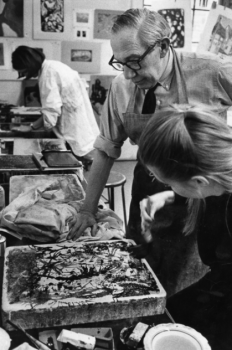Arcadia Exhibitions Presents “Living Rocks: Benton Spruance and the Lithographic Process” Through Dec. 17

A gallery talk by Shelley Langdale, associate curator of prints and drawings, Philadelphia Museum of Art, will take place on Dec. 6 in the Arcadia University Art Gallery beginning at 6 p.m. with a reception to follow.
Arcadia Exhibitions is pleased to announce “Living Rocks: Benton Spruance and the Lithographic Process” on display through Dec. 17 in the Arcadia University Art Gallery, located in the Benton Spruance Art Center.
Benton Spruance (1904-1967) was an internationally recognized printmaker, educator and leading figure in the Philadelphia art community. Known during his lifetime as the “Dean of Philadelphia Lithographers,” his pioneering work in color lithography brought forth innumerable accolades, including two Guggenheim Fellowships.
The exhibition explores Spruance’s commitment to the medium with which he was so closely associated by presenting the preliminary materials generated during the painstaking process of producing his completed works. Lithography (from the Greek word “lithos,” meaning stone) is a method for generating prints requiring multiple steps that involves drawing with touche, a liquid oil-based ink onto a block of limestone. The image is subsequently etched chemically into the stone’s smooth surface and its reverse is transferred to paper by placing the sheet atop the stone and running both through a press.
On display will be examples of Spruance’s sketches (rendered in ink, pastel or paint), resulting proofs, and color tests alongside examples of the finished prints. These pairings have been selected to represent various stages of visual evolution throughout Spruance’s long and prolific career. The show begins with samples from the 1930s and 40s that are distinguished by their rigorous, structural design and socially conscious imagery influenced by American Regionalist era artists such as Thomas Hart Benton. It then proceeds into an exploration of more gestural, abstracted mythological, biblical, and literary figures that dominated his later output. The context generated by these combinations will attempt to reveal how Spruance’s devotion to this demanding, step-by-step process impacted the development of his imagery.
Beginning his career at Beaver College in 1926 as a part-time instructor while still a student at the Pennsylvania Academy of Fine Arts, Spruance was made a full professor and chair of the Art Department in 1933, a position he held for 34 years. He remains the only active Beaver College professor to have also served on the school’s Board of Trustees. On campus he was known as a gifted lecturer on the subject of art history – unregistered students would regularly attend his courses – and as a demanding but compassionate mentor in the studio. His involvement with the Philadelphia Art Commission in 1953 led to a city ordinance requiring that one percent of the cost for construction of new public buildings be allocated to the creation and placement of works of art. This “percent for the arts” model has been emulated by many other cities, and has become one of the cornerstones for funding of public art in America.
Curated by Exhibitions Coordinator Matthew Borgen, this show – the first to present the artist’s process in detail – coincides both with the 50th anniversary of Spruance’s death, as well as with the completion, shortly thereafter, of the expansion to Brookside Hall begun in 1966 under his guidance. This complex was dedicated as the Benton Spruance Art Center in 1969 and still serves as the home of the Department of Visual and Performing Arts today.
Shelley Langdale, associate curator of Prints and Drawings at the Philadelphia Museum of Art, will give a gallery talk about the works in the exhibition in the Benton Spruance Art Center on Dec. 6 beginning at 6 p.m. A reception —accompanied by tours of some of the Department of Art and Design’s newly renovated studio facilities, including areas of the 1966 addition to the art center overseen by Spruance himself— will follow immediately afterwards. All events are free and open to the public.
Further information about forthcoming events being organized in conjunction with this exhibition can be found at gallery.arcadia.edu or by contacting Arcadia Exhibitions at (215) 572-2131.


